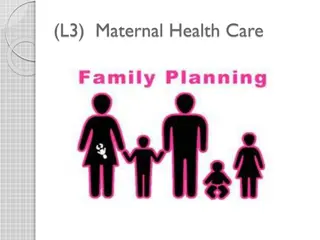Understanding Family Dynamics and Health Impacts
Family dynamics play a crucial role in determining overall health, encompassing various factors like genetics, lifestyle, finances, and health-seeking behaviors. A healthy family structure characterized by effective communication, support networks, and personal autonomy can promote mental well-being and social stability. Recognizing the impact of family dynamics on health is essential for a comprehensive Bio-psych-social approach in healthcare.
Download Presentation

Please find below an Image/Link to download the presentation.
The content on the website is provided AS IS for your information and personal use only. It may not be sold, licensed, or shared on other websites without obtaining consent from the author. Download presentation by click this link. If you encounter any issues during the download, it is possible that the publisher has removed the file from their server.
E N D
Presentation Transcript
Family Dynamics Ntokozo Nxele Simiso Siwawa Carol Maluleke
It means different things to different people 1. Unit of two or more persons united by marriage, blood, adoption or consensual unit consulting a single household, interacting and communicating (Desai, 1994) 2. A group of people related either by consanguinity or affinity (by marriage or other relationship), (definition adopted by WHO) Definition of Family 3. Family is a kinship unit and that even when its members don t share a common household, the unit may exist as a social reality (UNESCO report)
Characteristics of healthy family structure 1. Healthy communication: freedom of expression 2. Personal autonomy: equal power 3. Appreciation: praise and encouragement, promoting healthy self esteem 4. Support Networks 5. Family time 6. Spouse bonding 7. Growth: encouraging environment promotes growth of individual members 8. Spiritual and religious values
The patient and family dynamics Health is multifactorial WHO describes health as a state of complete physical, mental and social well being and not merely the absence of disease and infirmity Family can determine or impact your health Genetics Lifestyle Finances Health seeking Behaviours Ultimately family and environmental factors can affect health family living in harmony promotes good mental health and social stability Addressing these determinants of health forms part of Bio-psych-social approach
PHC we see patients who present with physical symptoms that a primary emotional or psychosocial basis, with no organic cause In order to understand the clinical presentations, we have to have an understanding of underlying precipitants or external factors that may lead to presentation Otherwise we end up treating the symptoms and not the cause
CLINICAL SETTING EXPLORING THE PRESENTING COMPLAINTS
DUVALLS FAMILY DEVELOPMENT AND LIFE CYCLE THEORY Developed in 1988 Families follow a predictive pattern comprising of 8 stages of development Each stage of development poses a potential threat to the health of the family members involved
LIMITATIONS OF DUVALLS THEORY Designed for nuclear families Arrests in the life cycle The chronology of the sequence of events
HOW TO ASSESS FAMILY DYNAMICS IN THE CONSULTATION ROOM 1. THE GENOGRAM
GENOGRAM CONT. A summary of the patient s context Highlights patterns of illness in the family and psychosocial relations Therapeutic and preventative tool Time consuming Informant dependent
2. THE BATHE TECHNIQUE Elicits the social context of the patient s visit Enhances rapport
Family APGAR Family APGAR: Introduced by Gabriel Smilkstein is a family function test designed to assess five areas of family function. A: Adaptation P: Partnership G: Growth A: Affection R: Resolve Part 1: Part 2: 8-10 Highly functional 4-7 Moderately dysfunctional 0-3 Severely Dysfunctional
Intervention Doherty and Baird: Five Levels of Primary Care Collaboration
Pitfalls Boundaries: if the general practitioner becomes too involved with the family the could end up taking the role of rescuer Not all members of the family may be available for intervention Taking sides Confidentiality
Avoiding Pitfalls Enable autonomy Encourage teamwork
References 1. Sharma, R. 2013. The Family and Family Structure Classification Redefined for the current times. J Family Med Prim Care pp:306-310. 2. Kim JH, Park YN, Park EW, Cheong YS, Choi EY. Effects of BATHE Interview Protocol on Patient Satisfaction. Korean J Fam Med. 2012;33(6):366-371. 3. G. Pirooz Sholevar. Family development and life cycle; Psychiatry Journal/ Child psychiatry 94(2): 1-8.























